|

Summer
1999 (7.2)
Pages
20-25
Not So Black
and White
Azerbaijan's
Younger Generation of Artists
by Aneta
Georgievska-Shine
The
author, an art historian, visited Azerbaijan a few years ago.
Here she speaks about her conversations with the country's younger
artists (mostly in their twenties and thirties). She found them
to be more concerned about the timeless questions engendered
by art rather than worrying about seeming "outdated"
as compared to artists from other countries. Rather than imitating
the latest trends of Western art, they want their art to fit
into the context of their own native traditions. At the same
time, however, they have to maintain a delicate balance between
following these artistic goals and the very pressing need to
make a living.
_____
During my trip to Azerbaijan as an artistic advisor for the Amoco
Foundation of Houston, Texas, I experienced the proverbial cultural
shock of a first-time visitor. I accompanied Dr. Meda Mladek,
Director of The Central and East European Art  Foundation,
a Washington-based non-profit organization that promotes the
arts of countries formerly behind the "Iron Curtain".
Our immediate task was to survey the art scene in Baku, with
the ultimate goal of organizing an exhibition that would bring
a selection of contemporary art from Azerbaijan to a Western
audience. Foundation,
a Washington-based non-profit organization that promotes the
arts of countries formerly behind the "Iron Curtain".
Our immediate task was to survey the art scene in Baku, with
the ultimate goal of organizing an exhibition that would bring
a selection of contemporary art from Azerbaijan to a Western
audience.
Our first pleasant surprise was the unprejudiced use of the Russian
language by almost every artist we met, as soon as they realized
that it would help our communication (since we both spoke Russian
ourselves). It soon became clear that this attitude towards things
associated with the former Soviet Union extended beyond linguistic
tools. Instead of the misdirected national pride of other "newly
independent" states, we encountered a genuine differentiation
between ideology and culture. Azerbaijanis understand that the
rejection of a political system does not necessarily entail a
wholesale rejection of the culture with which that system was
associated.
|

Sakit Mammadov
"Nargiz"
40 x 40 cm, oil on canvas
1997
Contact in
Baku
Tel: (99-412) 60-09-07
|
 |
East Meets West
To paraphrase
one of the first artists we met, their art was indebted to Moscow
and St. Petersburg for implanting the West in the  Caucasus.
Fragile, often poorly printed reproductions of works by Dürer,
Leonardo da Vinci, Rembrandt, Picasso and Matisse were tacked
to many studio walls, reinforcing that statement. More importantly,
the self-identity of Azerbaijani artists as participants in the
European academic tradition was demonstrated by their work. Caucasus.
Fragile, often poorly printed reproductions of works by Dürer,
Leonardo da Vinci, Rembrandt, Picasso and Matisse were tacked
to many studio walls, reinforcing that statement. More importantly,
the self-identity of Azerbaijani artists as participants in the
European academic tradition was demonstrated by their work.
Yet, while they embrace and take as their starting point the
western language of easel painting and sculpture, they attempt
to combine it with the visual and conceptual heritage of their
segment of the Orient-the painted miniatures, the maze of ornaments
in metalwork, sarcophagi and architectural embellishments, the
vivid patterns of carpets and textiles and the canonical stories
of the past rendered in pictorial form.
|

Togrul Dadashov
"Five"
30 x 10 x 10 cm
bronze, stone and marble
1996
Contact in
Baku
Home: (99-412) 32-17-78
Studio: 60-13-40
|
 |
Where
does the "younger" generation of artists fit into all
this? How do they feel about the newly gained freedom from politically
endorsed and proscribed styles? Do they live with a sense of
isolation from what has been going on in the West over the past
century? How do they react to the increased, yet still second-hand
and restricted access to new "trends" from the artistic
centers of Europe and North America?
The answers to some of these questions came as we listened to
the impressions of a group of young artists in their late twenties
to mid-thirties. They had just returned from a biennial exhibition
in Tbilisi, where they exhibited works together with their peers
from Georgia, Armenia and Russia. They were clearly disaffected
by what they had seen-too much programmatically political art
and too many half-understood experiments blindly derived from
the West. They saw a great deal of conceptual art,
mostly installations, rather than traditional painting or sculpture.
In other words, there was a clear attempt to jump into the latest
fashions of video and computer-generated art driven by certain
critics and the art market.
|

Namig Mammadov
"About Mother"
120 x 75 cm.
Contact in
Baku: (99-412) 38-28-25.
|
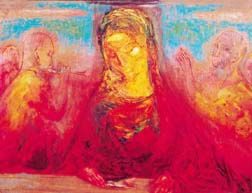 |
Ties to Tradition
As they
spoke about how "outdated" the Azerbaijani artists
appeared at this exhibition, there was neither a sense of misgiving,
nor a desire to adjust to what they had seen. On the contrary,
there was a sense of self-confidence about their adherence to
a valuable tradition and a resolve not to give in to a seemingly
novel artistic language that, as they repeated, neither the artists
who played that game, nor their audience, understood. To recall
the words of one, who spoke for many: "We may seem hopelessly
old-fashioned to them with our oil on canvas, our still lifes
and landscapes, but this is the cultural territory we come from.
The tasks we give ourselves as artists are intimately tied to this tradition. We work and depart from it, but remember
its rules as our coordinates. To do otherwise would be artificial."
tied to this tradition. We work and depart from it, but remember
its rules as our coordinates. To do otherwise would be artificial."
|

Elnur Babayev
"Crying Angel"
120 x 90 cm
oil on canvas, 1997.
Contact in
Baku:
Tel: (99-412) 38-22-87 or 38-56-33
|
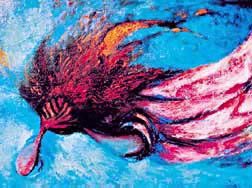
|
Their works reflected the conviction of their words. One young
woman, who was working on an abstract composition in subdued
browns and deep reds, told us: "I've been dealing with this
for a long time, trying to represent this detail from an early
Renaissance painting, Giotto's figure of 'Charity'". The
answer was that simple: a formal, pure painting problem. When
asked about a recent exhibition in Berlin in which she had participated,
she spoke with undisguised contempt of a certain gallery owner
who had advised her to market herself as a woman-artist from
a cultural "province" or to paint works that dealt
with ecological issues or feminist concerns in an Islamic country.
Another artist showed us a recently completed still life, masterful
in its color and composition and fresh despite its traditionalism.
He spoke of trying to capture the glow of the afternoon light
on empty bottles left upon a table and the sense of peace that
he was trying to capture in the work.
|

Shahin Shikhaliyev
"Loneliness"
120 x 100 cm, oil on canvas 1996
Contact in
Baku
Tel: (99-412) 38-41-64.
|
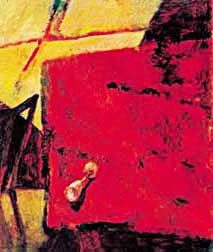 |
Disregarding Trends
When we discussed the issue of the artistic freedom that could
be gained by  the
use of unconventional materials or a more decisive departure
from subject matter and story-telling, we were told: the
use of unconventional materials or a more decisive departure
from subject matter and story-telling, we were told:
"Undoubtedly, the use of less traditional media could help
us. We could make sculptures in cheaper materials than stone
or we could construct larger works with less expensive canvases
and paints. We could also go for total abstraction and larger
work in general, despite our small studios. But would this necessarily
mean a greater freedom? A small Renaissance painting of Madonna
with the Christ Child can be as free as a totally abstract, large-scale
work done today. Artistic freedom is always pursued within a
framework that defines and constrains it, whether this framework
be social, economic or purely formal. Freedom is relative, just
like a white dot placed next to a dark one appears whiter than
it is, and turns the dark one into black."
This is not to say that these members of the younger generation
of Azerbaijani artists are totally apolitical, turned inward,
and simply creating art for art's sake. Rather, they refuse to
reduce the creation, contemplation and discussion of art
matters to a political statement or a ploy to gain easier entry
into the art  market. market.
|
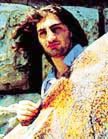
Bahram Khalilov (1970-), "The Window", 36.5 x 27.5
cm, oil and enamel on wood and glass.
Contact in
Baku:
Tel: (99-412) 98-16-23
|

|
Nor do we claim that this purity of intention should be taken
at face value. Money does not exert its power only over the work
of some older, more established artists, who increasingly churn
out smaller paintings and sculptures for quick sale to foreign
visitors or shipment to commercial galleries abroad (mostly Turkey).
The difficult economic conditions in Azerbaijan and reduced institutional
support for the arts compel a number of younger artists to follow
the same course. When necessary, they also sell their paintings,
though they assured us (and themselves) that the commercial factor
is the least consideration on their scale of priorities.
Need for Feedback
Which
leads us to one last question: what kind of help would they like?
 Again,
we were struck by the degree of artistic integrity in their responses: Again,
we were struck by the degree of artistic integrity in their responses:
"We do not hope for great projects that will change our
position as a cultural presence in the world. We do not hope
for sudden success in commercial galleries in the West. What
we lack is a dialogue with art professionals from abroad who
could give us critical feedback about what we are doing as artists.
We seek people who would care enough to tell us where we are
in comparison to others. We know that we have been isolated.
But perhaps, there was something good about that isolation. Perhaps
what we have learned about trends in the West, however limited,
is sufficient. Now we would like people who like art and who
work with art to come and see what has been happening here, despite
our isolation-to simply take some time and have a sincere exchange
of ideas with us."
Whether they will be able to meet the challenges of the inevitably
deeper encounter with the artistic currents and realities of
the world art market is an open question. For the time being,
however, the work some of them create and the terms in which
they discuss its engagement, despite the rapid changes of their
environment, is encouraging.

Vugar Muradov
Series of Portraits
50 x 70 cm, pastel on paper
1993-97
Contact in Baku
Home: (99-412) 32-55-96
Studio: 38-29-93 |
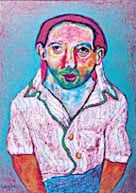 |
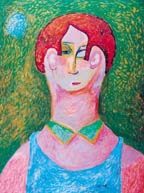 |
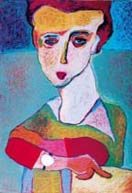 |
The author, a Washington-based
art historian, and Dr. Meda Mladek, President of the Central
and East European Art Foundation, spent two weeks in Azerbaijan
in October of 1996. The statements in quotes are paraphrased
excerpts from discussions with numerous artists from the younger
generation, including, among others: Shahin Shikhaliyev, Sabina
Shikhlinskaya, Elnur Babayev, Husein and Ujal Hagverdiyev, Elchin
Nadirov, Eliyar Alimirzayev and Zagir Huseinov. The works of
these artists will be exhibited on the AZ Art Gallery on the
Internet organized by Azerbaijan International magazine. Visit
www.azer.com beginning in mid-summer
1999.
 _____ _____
From
Azerbaijan
International
(7.2) Summer1999.
© Azerbaijan International 1999. All rights reserved.
Back to Index
AI 7.2 (Summer 99)
AI Home
| Magazine
Choice | Topics
| Store
| Contact
us
|
















